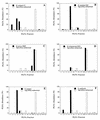Radioactive fingerprinting of microorganisms that oxidize atmospheric methane in different soils
- PMID: 10473417
- PMCID: PMC99742
- DOI: 10.1128/AEM.65.9.4064-4070.1999
Radioactive fingerprinting of microorganisms that oxidize atmospheric methane in different soils
Abstract
Microorganisms that oxidize atmospheric methane in soils were characterized by radioactive labelling with (14)CH(4) followed by analysis of radiolabelled phospholipid ester-linked fatty acids ((14)C-PLFAs). The radioactive fingerprinting technique was used to compare active methanotrophs in soil samples from Greenland, Denmark, the United States, and Brazil. The (14)C-PLFA fingerprints indicated that closely related methanotrophic bacteria were responsible for the oxidation of atmospheric methane in the soils. Significant amounts of labelled PLFAs produced by the unknown soil methanotrophs coeluted with a group of fatty acids that included i17:0, a17:0, and 17:1omega8c (up to 9.0% of the total (14)C-PLFAs). These PLFAs are not known to be significant constituents of methanotrophic bacteria. The major PLFAs of the soil methanotrophs (73.5 to 89.0% of the total PLFAs) coeluted with 18:1 and 18:0 fatty acids (e.g., 18:1omega9, 18:1omega7, and 18:0). The (14)C-PLFAs fingerprints of the soil methanotrophs that oxidized atmospheric methane did not change after long-term methane enrichment at 170 ppm CH(4). The (14)C-PLFA fingerprints of the soil methanotrophs were different from the PLFA profiles of type I and type II methanotrophic bacteria described previously. Some similarity at the PLFA level was observed between the unknown soil methanotrophs and the PLFA phenotype of the type II methanotrophs. Methanotrophs in Arctic, temperate, and tropical regions assimilated between 20 and 54% of the atmospheric methane that was metabolized. The lowest relative assimilation (percent) was observed for methanotrophs in agricultural soil, whereas the highest assimilation was observed for methanotrophs in rain forest soil. The results suggest that methanotrophs with relatively high carbon conversion efficiencies and very similar PLFA compositions dominate atmospheric methane metabolism in different soils. The characteristics of the methane metabolism and the (14)C-PLFA fingerprints excluded any significant role of autotrophic ammonia oxidizers in the metabolism of atmospheric methane.
Figures

References
-
- Bender M, Conrad R. Kinetics of CH4 oxidation in oxic soils exposed to ambient air or high CH4 mixing ratios. FEMS Microbiol Ecol. 1992;101:261–270.
-
- Benstead J, King G M. Response of methanotrophic activity in forest soil to methane availability. FEMS Microbiol Ecol. 1997;23:333–340.
-
- Borjeson G, Sundh I, Tunlid A, Svenson B H. Methane oxidation in landfill cover soils as revealed by potential oxidation measurements and phospholipid fatty acid analyses. Soil Biol Biochem. 1998;30:1423–1433.
Publication types
MeSH terms
Substances
LinkOut - more resources
Full Text Sources

